Temple of Heaven
May 5th, 2010 6 Comments Category: China Destinations Feed for this Entry
The Temple of Heaven (TianTan, Chinese: 天坛) was where emperors of the Ming and Qing dynasties would offer sacrifices to heaven and pray for good harvests. There are 12 million people visit the magnificent and colorful Temple of Heaven every year.
The ancient Chinese believed that Heaven was the supreme ruler of the universe and the fate of mankind, and thus worshiping rites dedicated to Heaven came into being.
Introduction to the Temple of Heaven

The Temple of Heaven was constructed between 1406 and 1420 during the reign of Ming Emperor YongLe (1403-1424), who also oversaw the creation of the Forbidden City during the same period. Situated in the southern part of the city, this grand set of structures covers an area of 273 hectares. To better symbolize heaven and earth, the northern part of the Temple is circular while the southern part is square. The whole compound is enclosed by two walls, a square wall outside a round one. The outer area is characterized by suburban scenery, while the inner part is used for sacrifices. The inner enclosure consists of the Hall of Prayer for Good Harvest and the Circular Mound Altar.

The Temple of Heaven was originally established as the Temple of Heaven and Earth, but was given its current name during the reign of Ming Emperor JiaJing (1522-1567), who built separate complexes for the earth, sun and moon. The Temple of Earth (DiTan) can be found in north Beijing. The temples of the sun and moon are in the east and west of Beijing.

The Temple of Heaven was renovated again during the reign of Qing Emperor QianLong (1736-1795).

In 1998, the Temple of Heaven was added to the UNESCO World Heritage List.

In early 2005, the Temple of Heaven underwent a 6 million USD renovation that was completed on May 1st, 2006.


The architecture and layout of the Temple of Heaven is based on elaborate symbolism and numerology.

In accordance with principles dating back to pre-Confucian times, the buildings in the Temple of Heaven are round, like Heaven (one can imagine the sky as like a rounded dome), while the foundations and axes of the complex are square (or 2 dimensional - that is, flat), like the earth (appears to be).
Thus, the buildings and their settings reflect ancient Chinese religious beliefs that imagine heaven as round and earth as square. The main buildings in the Temple of Heaven are constructed on a central north-south axis. The altar and temple are round and sit within square shaped areas.
Similarly, the northern part of the park is semicircular in shape while the southern part is square. The two parts are divided by a wall that has a semi-circular obtrusion in the middle around the Imperial Vault. This echos the shape of the park as a whole.
The roofs of the important structures in the Temple of Heaven are tiled in blue, the color symbolizing heaven and sky (just as golden yellow symbolizes the emperor and green Buddhism).
The symbolism at the Temple of Heaven was necessary because it served as the place where the emperor, as the 'Son of Heaven', directly beseeched Heaven to provide a bountiful harvest throughout the land. This was of great importance because during the imperial period agriculture was the foundation of China's wealth.
The Temple of Heaven, with its ancient cosmological basis, in turn helped to reinforce the legitemacy of the emperor's role as head of a feudal system with a mandate from Heaven. In showing respect to Heaven through prayer and sacrifices, the emperor effectively emphasized the source of his authority.



Map of the Temple of Heaven
The Three Main Structures of the Temple of Heaven
Three principle structures lie along the primary north-south axis of the Temple of Heaven complex : the Altar to Heaven, the Imperial Vault of Heaven and the Temple of Heaven.
The Altar to Heaven(Chinese:圆丘坛)


Approaching the Altar to Heaven. A triple set of 'LingXing Gates' can be seen in the foreground.
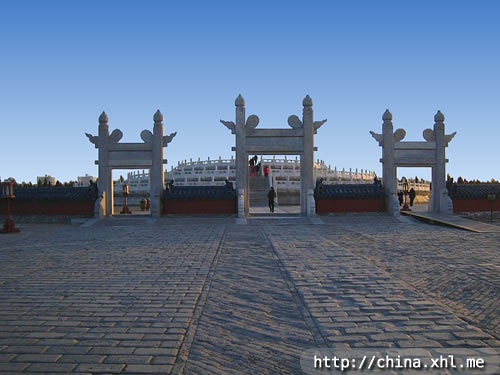
Within the walled square yard is a circular wall. Both inner and outer walls contain four sets of three gates that resemble monumental archways. These are known as the 'LingXing Gates' and are made of white marble.
At the southern end is the Altar to Heaven (also known as the 'Circular Mound'), an empty three-tiered plinth that rises 5 meters from a square yard.

Here, we can see the inner circular wall inside the square outer wall.
Constructed in 1530 and rebuilt in 1740, it is made of white marble. The altar was used to worship heaven at the winter solstice.
To the southeast of the Clircular Mound Altar lies a stove built of green glazed bricks. It was used to burn the sacrifices offered to the heaven. The eight iron-made stoves to the heaven. The eight iron-made stoves to the northeast of the stove were used to burn the sacrifices offered to the ancestors of the emperor.

Standing on the Heavenly Center Stone on top of the Altar to Heaven.
The first ring of consists of 9 stones, the 'magical' highest value digit. Then 18, 27 etc.
The number of stones in the various concentric tiers are all multiples of nine - a prevailing numerological theme at the Temple of Heaven. The number nine, being the highest value digit, symbolically represented the emperor.
Around the center stone is a ring of nine stones slabs. The next ring has 18 slabs; the next 27. There are nine rings in all, with 9 x 9 =81 slabs in the outermost ring. Thenumbers of the railing boards and balustrades are also the multiple of nine, all symbolic figures of the astronomical phenomena.
The central stone is called the Heavenly Center Stone. It is said that the voice of a person standing there sounds especially resonant and sonorous.

The view north towards the Imperial Vault with the Hall of Prayer for Good Harvests beyond.
The Imperial Vault of Heaven and the Echo Wall
At the center of the north-south axis of the Temple of Heaven are the Imperial Vault of Heaven and the Echo Wall that surrounds it.

Testing the reflection of sound waves at the Echo Wall.
The Echo Wall encloses the Imperial Vault. It has a height of 3.7 meters and a circumference of 193 meters. It is named for its acoustical properties - a whisper spoken at one end can be heard clearly from the other. Further, the Triple Echo Stones in the courtyard return various numbers of echos depending on which stone one stands on while facing the Imperial Vault. They good demonstra tions of the excellent skills of ancient architects in embroldering acoustics phenomena into their designing.
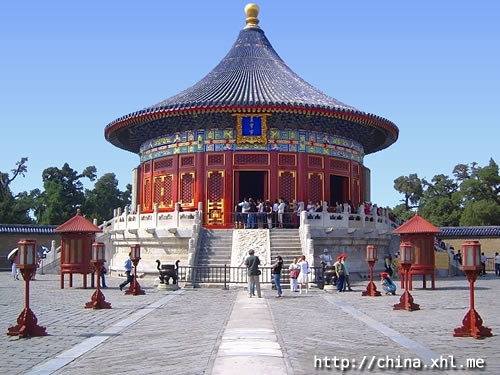
The Imperial Vault of Heaven.
The Imperial Vault of Heaven sits in the center. It is a round building with a roof that resembles the Hall of Prayer for Good Harvests, though smaller and with only one gable of eaves and a single tier marble base.
The back half of the Imperial Vault of Heaven is constructed with bricks.

The rear of the Imperial Vault of Heaven.
The Imperial Vault of Heaven was built in 1530 during the reign of Emperor JiaJing (Ming dynasty). It was rebuilt into the present form in 1752 by Emperor QianLong (Qing dynasty).
The hall is 19.2 meters high and with a diameter of 15.6 meters.
The east and west annexes were used to hold divine tablets of various gods worshipped at the Altar to Heaven.
In the past, the vault contained memorial tablets of the emperor's ancestors.

One of the two halls in front and to the sides of the Imperial Vault.

The entrance to the Imperial Vault of Heaven as seen from inside.
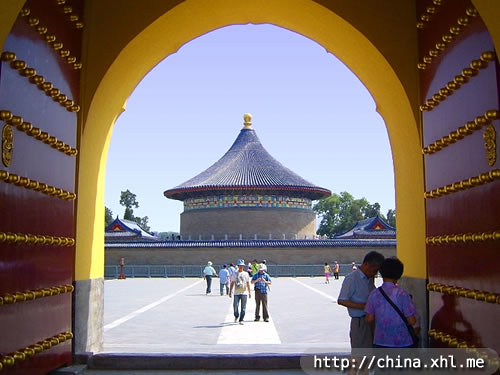
Looking towards the north side of the Imperial Vault of Heaven through the central archway of ChengZhen Gate.
DanBi Bridge(DanBi Qiao)(Chinese:丹陛桥)
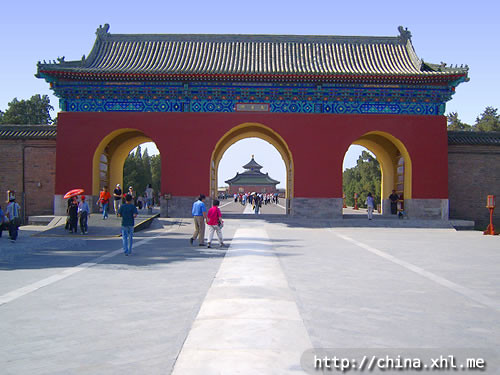
One approaches the Hall of Prayer for Good Harvests along a 360 meter raised walkway : 'Vermillion Steps Bridge' (DanBiQiao). In doing so, one ascends almost imperceptibly, denoting progression from Earth to Heaven. The path is 1 meter high at the start and 4 meters high at the end. It is called a bridge because at one point there in a tunnel under it.
The walkway is almost 30 meters wide and has three distinct paths marked out. The central path was reserved for the gods. The path on the east was reserved for the emperor while the path on the west was used by the empress and court officials.

The walkway of DanBi Qiao.
The walkway is flanked by centuries-old cypress trees. Someone more than 400 or 500 years old.

Approaching the Hall of Prayer for Good Harvests.
The Hall of Prayer for Good Harvests(Chinese: 祈年殿)
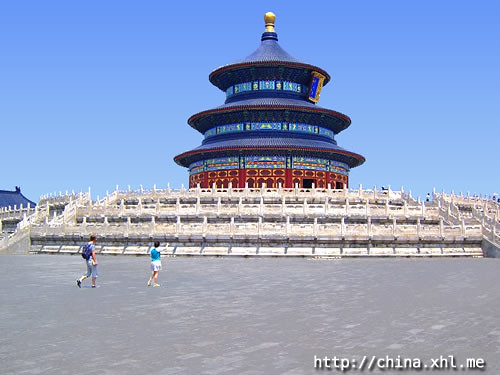
The magnificent Hall of Prayer for Good Harvests.
At the north end of the Temple of Heaven is the majestic Hall of Prayer for Good Harvests, an impressive three-tiered wooden structure that sits on a large, three-tiered marble plinth, 6 meters high.
The hall itself is 38.2 meters high (32 meters from the plinth) and 24.2 meters in diameter. Remarkably, not a single nail was used in its construction - a feat that required a high level of craftmanship.
Initially constructed in 1420 in a square design, it was reconstructed in 1545 during Emperor JiaJing's reign as a round building with a three-tier roof much as we know it today. At that time the roof was constructed with blue, yellow and green glazed tiles symbolising Heaven, Earth and the mortal world.
During Qing Emperor QianLong's reign it was reconstructed again in 1751. This time the roof was tiled only in azure colored tiles.
The hall burned down in 1889 and was rebuilt soon after. A major facelift was completed in 2005. It is the only existing example of the ancient Ming Tang architectural style.

Huge dragon depicting carved stones along the central stairway up to the hall. The emperor would be carried in a sedan over these carvings.
Inside the Hall are 28 tall pillars, each made from a single tree trunk. The four posts around the inner circle represent the four seasons. The 12 posts around the middle circle represent the 12 months. The 12 posts of the outer circle represent 12 ShiChen. In ancient China, one ShiChen equalled two hours so that a complete day was divided into 12 ShiChens. The12 gilded pillars and the 12 outer eave pillars together represent the 24 solar terms of the year.
The designer used the numers of the pillars to represent the time division of the Chinese calendar about hour, day, month and season, and used the round shape of the structure to represent the endles time and its repetition in endless circles. It is indeed a building of time.
 Looking inside the Hall of Prayer for Good Harvests.<
Looking inside the Hall of Prayer for Good Harvests.<
Inside the Hall are 28 tall pillars, each made from a single tree trunk. The four posts around the inner circle represent the four seasons. The 12 posts around the middle circle represent the 12 months. The 12 posts of the outer circle represent 12 ShiChen. In ancient China, one ShiChen equalled two hours so that a complete day was divided into 12 ShiChens. The12 gilded pillars and the 12 outer eave pillars together represent the 24 solar terms of the year.
The designer used the numers of the pillars to represent the time division of the Chinese calendar about hour, day, month and season, and used the round shape of the structure to represent the endles time and its repetition in endless circles. It is indeed a building of time.

The interior of the hall is magnificently decorated and contains a large south facing ceremonial throne.

The northern gateway to the Hall of Prayer for Good Harvests, with the Imperial Hall of Heaven just to the north.
From 1751 onwards, the Hall was used exclusively to pray for good harvests at the winter solstice.
The Celestial Stones and the Long Corridor
The Seven Celestial Stones(Chinese: 七星石)
These are located near the Long Corridor and east gate to the Temple of Heaven.
These giant pacifying stones were placed here during the reign of Emperor JiaJing. They have motifs of mountains engraved on them symbolising the seven peaks of the TaiShan mountains. They are not meteors as sometimes said in folklore.
When the Manchus came to power in central China, Emperor QianLong ordered the placement of an additional stone here facing northeast to indicate that the Manchu is one of the nationalities of China. Hence there are actually eight stones in total.

The Long Corridor(Chinese: 长廊)
The Long Corridor is 5 meters wide and 350 meters long. It has a wall along one side.
The Long Corridor is a covered passageway that connects the animal killing pavilion, 'Divine Kitchen' and Hall of Prayer for Good Harvests.
If one considers the space between four pillars as a 'room', then the Long Corridor can be seen as 72 consecutively connected rooms.

On the eve of a sacrificial ceremony, the corridor would be lit by lanterns as jade, silk, grains and fruit was transported to the altars.
The Hall of Abstinence(Chinese: 斋宫)

The Hall of Abstinence was first built in 1421. The emperor would reside here to observe abstinance in the days before a sacrificial ceremony.
The buildings at the Hall of Abstinence are different from those in the Forbidden City in terms of roof color and the direction they face. In the Forbidden City the building facing to south, and with gloden yellow roof , but here facing east with green roof. It's because the ancient ruler claimed him to be the son of the heaven, and the Temple of Heaven was where his father lived-heaven god, so he must be as son while be here. So the houses would all face east and have the same greenroof as those for prince.
According to the warshipping rites,the emperor should have three days of fast bdfore going to the temple to affer sacrifices to his father-two days in the Forbidden City and one day in the Temple of Heaven. Therefore, there was also a Hall of Abstinence inside the Forbidden City.


The Double-Ringed Pavilion of Longevity(Chinese: 双环万寿亭)

The virtually unique double-ring Pavilion of Longevity.
The double-rin Pavilion of Longevity was comissioned by Qing Emperor QianLong for his mother's 50th birthday. It was originally situated in ZhongNanHai, just south of BeiHai, and moved here in 1978. It is a rather unique and interesting structure, although has nothing to do with the Temple of Heaven in it's original form or function.


Fan-shaped pavilion facing the double-ring pavilion.
The Gardens(Chinese: 花园)

The Temple of Heaven grounds are liberally forested with many long peaceful walkways.

The Temple of Heaven contains a large number of ancient trees, some famous, such as the 'Nine Dragon' cypress tree on the north west outside of the Imperial Vault.


The Historical Role of the Temple of Heaven
A bi-annual procession consisting of thousands of eunuchs and ministers, plus the emperor (the Son of Heaven), would make its way from the Forbidden City to the Temple of Heaven. Ordinary citizens were not allowed to watch, or even see, the procession.
Among the gods worshiped at the Temple of Heaven originally were the god of earth, the god of water, the god of agriculture (who has his own hall - the Hall of Prayer for Good Harvests), the god of the military, the god of religion and the god of civilians.

Part of the large southern entry gate to the Hall of Prayer for Good Harvests.
At the Temple of Heaven, the emperor would perform sacrifices and other rituals. First, the emperor would fast in the Hall of Abstinance for several days.
Offering sacrifices was a serious task - the entire empire relied on the emperor for good fortune and abundant harvests so he had quite a responsibility. News of the ceremony was then disseminated throughout China.

Floral display outside the west gate of the Hall of Prayer for Good Harvests. Each summer a large display is created using thousands of small flower pots.



The Temple of Heaven Today
The Temple of Heaven has been converted into a park that is popular both with tourists and locals.
The park was first opened to the public in 1912 and commoners who had previously been banned from even watching the emperor's procession pass through the city to Tiantan, were now permitted to visit the Temple of Heaven themselves.

The Temple of Heaven is a very large park, more than twice the size of the Forbidden City. As this was to be the space representing Heaven on Earth, symbolically it needed to be bigger than the Forbidden City. It is about 2 kilometers from north to south. The inner walled area that houses the main structures covers 275 Hectares (2.75 million square meters). Indeed, it is the largest group of constructions for worship in the world.
The Temple of Heaven is a delightful and exquisite place to spend some time. Arrive in the early morning to watch the TaiChi experts, although the park is lively all day and into the evening with kite flyers, musicians, singers, dancers and games players (from badmington to chinese chess). Especially popular as a gathering place is the Long Corridor near the New East Gate.
The Temple of Heaven lies not far south from ChongWenMen subway station (25 minutes if walk).
Tags: Beijing, Temple of Heaven, TianTan
6 Comments
May 8th, 2010 at 08:46 pm
beautiful photos!
June 5th, 2010 at 04:41 am
Welcome to china
December 20th, 2010 at 10:08 am
Wow this is a great resource.. I’m enjoying it.. good article
December 23rd, 2010 at 06:20 am
Keep posting stuff like this i really like it
January 2nd, 2011 at 06:14 pm
this post is very usefull thx!
April 25th, 2011 at 10:43 am
Hi there! I fully agree with your thoughts. I’ve just added it to bookmarks.
Leave a comment